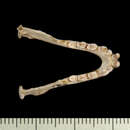en
names in breadcrumbs


The discovery of N. rabori is of particular interest because, like three other genera of fruit bats, Nyctimene occurs on Celebes and in the Philippines but not on Borneo. This group therefore transcends Wallace's line, the zoogeographic boundary of the Oriental faunal region that follows the edge of Asia's continental shelf. This pattern of species distributions is very different from the pattern for other mammals, and is probably due to the vastly increased dispersal abilities of flying mammals.
Perception Channels: tactile ; chemical
Human activities have resulted in the loss of much of this tube-nosed fruit bat's forest habitat. If the forest fragments where it still lives are adequately protected, the species may survive.
IUCN Red List of Threatened Species: endangered
Tube-nosed fruit bats are dispersers of fruit tree seeds, and may help control pest insect populations.
Little is yet known about the habits of this recently (1984) described species, but, like other Nyctimene species, it probably eats a variety of local fruits and perhaps some insects as well.
Nyctimene rabori is found on Negros, Cebu, and Sibuyan Islands, in the central Philippines.
Biogeographic Regions: oriental (Native )
Other Geographic Terms: island endemic
Nyctimene rabori is found only in tropical, forested areas, and probably mainly utilizes the high canopy.
Habitat Regions: tropical ; terrestrial
Terrestrial Biomes: rainforest
The striking physical features from which this animal gets its name are its tubular nostrils, which are separate and are about 6mm long. Body coloration is sexually dimorphic, with females being a light golden brown or buff color, and males a darker, more chocolatey brown. Both sexes have a dark stripe extending from the shoulders to the tail and light spots on their ears and wings. The bats measure about 142 mm in total length, with tail 25 mm, ear 20 mm and forearm 76 mm.
Other Physical Features: endothermic ; bilateral symmetry
Reproduction is known to occur in May and June, based on a small number of specimens that were collected while lactating (females) or in breeding condition (males). The duration of the breeding season and other details of the species' reproductive behavior have not yet been studied by researchers.
Key Reproductive Features: gonochoric/gonochoristic/dioecious (sexes separate); sexual